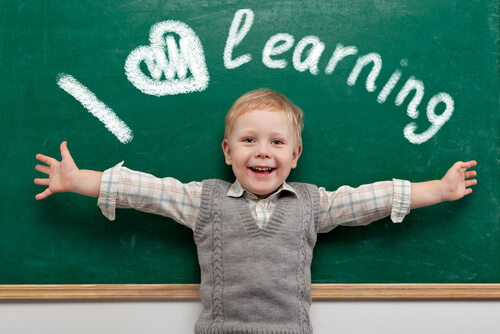The Kumon Method: A System for Autonomous Learning

The Kumon method is a Japanese learning system that focuses on the acquisition of math and language skills through a self-taught approach.
The Kumon method aims to develop a child’s individual learning potential. It’s based on two programs: one for math and the other for reading.
Rather than pursuing the acquisition of specific skills, this method aims to prepare students for autonomous learning. This is achieved through acquiring a habit of continuous study and an individualized learning plan.
How did the Kumon method arise?
“Every child has the potential to excel and exploit their skills.”
The Kumon method was created by Toru Kumon in 1954. The Japanese teacher started developing a mathematics program initially to help his son who had difficulties learning the subject. Later, he also created a reading and language program which led to the current system.
Kumon firmly believed that every child has the potential to excel and exploit his or her natural skills. That’s why a learning system was needed which would allow for children to expand their capacities to the maximum.

Objectives of the Kumon method
The practice of this method centers around an individual and personalized curriculum. Each student advances at his own pace. This method allows children to:
- Master the most basic concepts of math and language.
- Improve concentration, organization and study habits.
- Develop their potential.
- Increase self-confidence and discipline.
- They will feel motivated and satisfied on a personal level.
- They will be self-taught, this will allow them to study by themselves.
What is the method based on?
This system has two main branches – mathematics and language. Each one of the two branches are treated differently. In both branches however, the exercises start out simply and as the student progresses, they slowly increase in difficulty.
The method for mathematics is based on the repetition of basic exercises such as addition, subtraction, multiplication and division. These exercises will become progressively more complex until they reach an advanced level.
In language, on the other hand, the exercises focus on the stages of reading and word formation.
The key to this learning method lies in its continuity and the fact that it’s a self-taught approach. The teacher will be more like a guide who will reinforce the child’s weak points by programming tasks. Occasionally, the teacher can “give clues” which will help children resolve certain tasks.
“With the Kumon method, the teacher is nothing more than a guide who accompanies the students as they make their own discoveries.”
At what age can it start?
One of the main characteristics of the Kumon method is that there is no established age to start. Although it’s recommended for children to start as soon as possible, it can be applied at any time. It can be used to enhance a student’s potential from childhood to their university education.
The students using this method study according to their individual capacity. There are no limits such as age or grade. This way, children can enjoy learning and the satisfaction of achieving good results after making an effort.
One of the main benefits of this method is that it gives children the ability to learn on their own. Students will be able to read, think and rethink problems until they reach a solution by themselves.
The role of parents
Although the main objective of this method is for children to be self-taught and able to solve challenges on their own, parents need to accompany them. This methodology can be compared to a triangle whose vertices would be the student, counselors and parents.

The student’s family should provide important support, especially during the first years of their lives.
When it comes to the Kumon method, parents can also play a fundamental role. Their duties include the following:
- Checking exercises that children solve at home. This won’t take a lot of time. By turning homework into a shared experience, children may feel more satisfaction and motivation to complete their work.
- Motivate children continuously. Studying isn’t a lot of fun for most children. This is also true when learning is proposed as an extracurricular activity (as the Kumon method suggests). Therefore, asses the effort that your child invests every day and encourage him to continue.
Where can children study the Kumon method?
There are many Kumon centers all over the world. Some of them are located in schools where the method is practiced as an extracurricular activity. Others are in independent centers which were exclusively created to develop the Kumon method.
If you would like to help your children improve their academic performance, try out the Kumon method. It could be a great alternative.
The Kumon method is a Japanese learning system that focuses on the acquisition of math and language skills through a self-taught approach.
The Kumon method aims to develop a child’s individual learning potential. It’s based on two programs: one for math and the other for reading.
Rather than pursuing the acquisition of specific skills, this method aims to prepare students for autonomous learning. This is achieved through acquiring a habit of continuous study and an individualized learning plan.
How did the Kumon method arise?
“Every child has the potential to excel and exploit their skills.”
The Kumon method was created by Toru Kumon in 1954. The Japanese teacher started developing a mathematics program initially to help his son who had difficulties learning the subject. Later, he also created a reading and language program which led to the current system.
Kumon firmly believed that every child has the potential to excel and exploit his or her natural skills. That’s why a learning system was needed which would allow for children to expand their capacities to the maximum.

Objectives of the Kumon method
The practice of this method centers around an individual and personalized curriculum. Each student advances at his own pace. This method allows children to:
- Master the most basic concepts of math and language.
- Improve concentration, organization and study habits.
- Develop their potential.
- Increase self-confidence and discipline.
- They will feel motivated and satisfied on a personal level.
- They will be self-taught, this will allow them to study by themselves.
What is the method based on?
This system has two main branches – mathematics and language. Each one of the two branches are treated differently. In both branches however, the exercises start out simply and as the student progresses, they slowly increase in difficulty.
The method for mathematics is based on the repetition of basic exercises such as addition, subtraction, multiplication and division. These exercises will become progressively more complex until they reach an advanced level.
In language, on the other hand, the exercises focus on the stages of reading and word formation.
The key to this learning method lies in its continuity and the fact that it’s a self-taught approach. The teacher will be more like a guide who will reinforce the child’s weak points by programming tasks. Occasionally, the teacher can “give clues” which will help children resolve certain tasks.
“With the Kumon method, the teacher is nothing more than a guide who accompanies the students as they make their own discoveries.”
At what age can it start?
One of the main characteristics of the Kumon method is that there is no established age to start. Although it’s recommended for children to start as soon as possible, it can be applied at any time. It can be used to enhance a student’s potential from childhood to their university education.
The students using this method study according to their individual capacity. There are no limits such as age or grade. This way, children can enjoy learning and the satisfaction of achieving good results after making an effort.
One of the main benefits of this method is that it gives children the ability to learn on their own. Students will be able to read, think and rethink problems until they reach a solution by themselves.
The role of parents
Although the main objective of this method is for children to be self-taught and able to solve challenges on their own, parents need to accompany them. This methodology can be compared to a triangle whose vertices would be the student, counselors and parents.

The student’s family should provide important support, especially during the first years of their lives.
When it comes to the Kumon method, parents can also play a fundamental role. Their duties include the following:
- Checking exercises that children solve at home. This won’t take a lot of time. By turning homework into a shared experience, children may feel more satisfaction and motivation to complete their work.
- Motivate children continuously. Studying isn’t a lot of fun for most children. This is also true when learning is proposed as an extracurricular activity (as the Kumon method suggests). Therefore, asses the effort that your child invests every day and encourage him to continue.
Where can children study the Kumon method?
There are many Kumon centers all over the world. Some of them are located in schools where the method is practiced as an extracurricular activity. Others are in independent centers which were exclusively created to develop the Kumon method.
If you would like to help your children improve their academic performance, try out the Kumon method. It could be a great alternative.
All cited sources were thoroughly reviewed by our team to ensure their quality, reliability, currency, and validity. The bibliography of this article was considered reliable and of academic or scientific accuracy.
- Orcos, L., Hernández-Carrera, R. M., Espigares, M. J., & Magreñán, Á. A. (2019). The Kumon method: Its importance in the improvement on the teaching and learning of mathematics from the first levels of early childhood and primary education. Mathematics, 7(1), 109. https://www.mdpi.com/2227-7390/7/1/109
- Ukai, N. (1994). The Kumon approach to teaching and learning. Journal of Japanese Studies, 20(1), 87-113. https://www.jstor.org/stable/132785
- Harefa, Y., & Siregar, M. S. I. (2017). A Study of Kumon Method in Teaching English At Kumon Learning Centre Setiabudi Medan. http://repositori.usu.ac.id/handle/123456789/7501
This text is provided for informational purposes only and does not replace consultation with a professional. If in doubt, consult your specialist.








